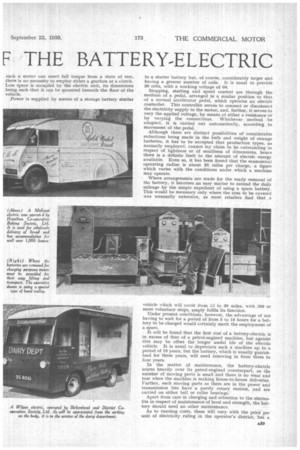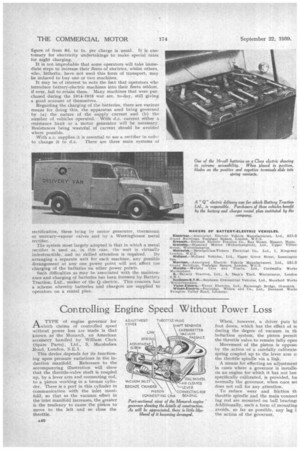WAR-TIME CLAD F THE BATTERY-ELECTRIC
Page 40

Page 41

Page 42

If you've noticed an error in this article please click here to report it so we can fix it.
A Clean Hygienic Form of Transport That is Non-depend Upon Imported Fuels. Simplicity of Control and Upk Big Factors in the Maintenance of Uninterrupted Sell
such a motor can exert full torque from a state of rest, there is no necessity to employ either a gearbox or a clutch. Less space is occupied by the electric unit, its dimensions being such that it can be mounted beneath the floor of the vehicle.
,Power is supplied by means of a storage battery similar
WIILST we have been assured that there are mense stocks of fuel in the country, it is perfectly obvious that the enormous demands of the Services will enforce the strictest economy in other spheres
of operation, essential as they may be to the well-being of the community.
Should hostilities be long drawn out and present stocks be seriously depleted, we may become immediately dependent upon speedy supplies as they come from abroad. This possibility naturally leads to serious consideration of the battery-electric vehicle for all types :°' work coming within its recognized sphere of operation,
Conditions that obtain to-day are materially different from those which existed at the outbreak of the last war, more particularly in relation to what might be termed the local delivery of such commodities as .bread, milk, meat, and so on. Whereas, at that time, the .form of transport mainly employed for such duties was the horsedrawn vehicle, to-day many thousands of motor vehicles are used for work of this description.
It is in this particular sphere of operation that the battery-electric machine shows up to special advantage, and, for this reason, the .claims to recognition which it makes are, to-day, increased a hundredfold.
A38 The battery-electric is, of course, independent of imported fuel because, excluding the large number of plants which are driven by oil engines, our main electricity supplies are obtained from coal fuel, of which we have almost inexhaustible supplies. So widespread are the coal-mining areas that interruption of supplies, as the result of enemy activities, is inconceivable.
Additionally, there is the Grid system which has made available electric power in districts that would normally be considered outside the economic radius for such a service.
To those who may not be aware of the capabilities of the battery-electric, it may not be out of place to give some idea of its general principles of construction, together with conservative-figures of operation.
An electric vehicle consists of a chassis similar in the main to that of a normal petrol-engined machine, an electric motor, however, taking the place of the petrol unit. As to a starter battery but, of course, considerably larger and having a greater number of cells. It is usual to provide 30 cells, with a working voltage of 60.
Stopping, starting and speed control are• through the medium of a pedal, arranged in a similar position to that of a normal accelerator pedal, which operates an electric controller, This controller serves to connect or disconnect the electricity supply to the motor, and, further, it serves to vary the applied voltage, by means of either a resistance or by varying the connections. Whichever method be adopted, it is carried out automatically, according to movement of the pedal.
Although there are distinct possibilities of considerable reductions being made in the bulk and weight of storage batteries, it has to be accepted that production types, as normally employed, cannot lay claim to be outstanding in respect of lightness or of smallness of dimensions, hence there is a definite limit to the amount of electric energy available. Even so, it has been found that the economical operating radius is about 35 miles per charge, a figure which varies with the conditions under which a machine may operate.
Where arrangements are made for the ready removal of the battery, it becomes an easy matter to extend the daily mileage by the simple expedient of using a spare battery. This would be necessary only where the area to be covered was unusually extensive, as most retailers find that a vehicle which will cover from .23 to 90 miles, with 200 or more voluntary stops, amply fulfils its function.
Under present conditions, however, the advantage of not having to wait for a period of from 5 to 10 hours for a battery to be charged would certainly merit the employment of a spare.
It will be found that the first cost of a battery-electric is in excess of that of a petrol-engined machine, but against this may be offset the longer useful life of the electric vehicle. It is usual to depreciate such a machine up to a Period of 10 years, hilt the battery, which is usually guaranteed for three years, will need renewing in from three to four years.
In the matter of maintenance, the battery-electric scores heavily over its petrol-engined counterpart, as the number of moving parts is small and there is no wear and tear when the machine is making house-to-house deliveries. Further, such moving parts as there are in the power and transmission line have a purely rotary motion, and are carried on either ball or roller bearings.'
• Apart from care in charging and attention to the electrolite in respect of maintenance of level and strength, the battery should need no other maintenance.
As to running costs, these will vary with the price per unit of electricity ruling in the operator's district, but a figure of from 6d. to Is, per charge is usual. It is customary for electricity undertakings to make special rates for night charging_ .
It is not improbable that some operators will take immediate steps to increase their fleets of electrics, whilst others, who, hitherto, have not used this form of transport, may be induced to buy one or two machines.
It may be of interest to note the faect that operators who introduce battery-electric machines into their fleets seldom, if ever, fail to retain them. Many machines that were pur. chased during the 1914-1918 war are, to-day, still giving a good account of themselves.
Regarding the charging of the batteries, there are various means for doing this, the apparatus used being governed by (a) the nature of the supply current and (b) the number of vehicles operated. With d.c. current either a resistance hank or a motor generator will be necessary. Resistances being wasteful of current should be avoided where possible.
With a.c. supplies it is essential to use a rectifier in order to change it to d.c. There are three main systems of rectification, these being by motor generator, therinionic or mercury-vapour valves and by a Westinghouse metal rectifier, The system most largely adopted is that in which a metal rectifier is used as, in this case, the unit is virtually
indestructible, and no skilled attention is required. By arranging a separate unit for each machine, any possible derangement at any one power point will not affect me charging of the batteries on other. power points.
Such difficulties as may be associated with the maintenance and charging of batteries has been foreseen by Battery Traction, Ltd., maker of the Q electric. This concern has a scheme whereby batteries and chargers are supplied to operators on a rental plan.
MAKERS OF BATTERY-ELECTRIC VEHICLES.
Eleetricar.—Aosociated Electric Vehicle Manufacturers, Ltd., 231-3 Orand Buildings, Trafalgar Square, London, W.C.2. Erewash.—Erewash Electric Traction Co., Ray Street, liettnor, Notts. Graiseley--Diamond Motors (Wolverhampton)., Ltd., Upper Villien Street, Wolverhampton. Metrovick.—Metropolitan-Viakers Electrical Co., Ltd,, 1, Kingsway London, W.C.2.
Midland.—Midland Vehicles, Ltd., Upper Grove Street, Leamingtor Spa.
Mere NOM—Assoc iatod Electric Vehicle Ma Hmfac hirers, Ltd., 231-3 Grand Buildings, Trafalgar Square, London, W.C.2. Murphy.—Murphy Cars and Trucl:s, Ltd., Cordwallis Works Maidenhead.
Q.—Battery Traction, Ltd., 4, Dean's Yard, Westminster, London s.W .1. Sunbeam-B.T.H.—Suniotam Commercial Vehicles, Ltd., Moortield Works Wolverhampton. Victor-Electric. —Victor Eiectrics, Ltd., Burscough Bridge, Gnu skirk. W ilson-Eleetric.—Ps rtridge, Wilson and Co., Ltd., Davenset Works Evtng too Volley Road, Leicester,




































































